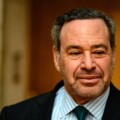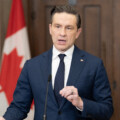Of all the terms used to describe the Conservative Party of Canada’s method of selecting its leader, “simple” is rarely among them.
On Saturday, September 10, the party’s seven-month-long leadership race will come to an end. By Sunday morning, barring complications, the public will know if Pierre Poilievre, Jean Charest, Leslyn Lewis, Roman Baber, or Scott Aitchison will lead the Tories into the fall parliament.
The results were to be announced at a party convention at Ottawa’s Shaw Centre for which tickets had been sold for $150 and a lineup of speakers including former Defence Minister and leadership aspirant Peter MacKay was set to address the Conservative faithful. Ian Brodie, chair of the leadership election organizing committee, announced on Thursday that in light of Queen Elizabeth’s passing, the party was considering changes to the convention.
Yet notwithstanding these evolving details of the leadership announcement itself, the basic process for how the leader is chosen — including the party’s unique model for converting votes into points — is unchanged.
Only Conservative Party members can vote for the new leader, and only via mail-in ballot as per the party constitution. The deadline to purchase a membership passed on June 3, after which members began mailing in their ballots during the voting period, which concluded on September 6.
Of the 678,702 members who were eligible to vote, the party reports that it received 437,854 ballots by the deadline — a roughly 65 per cent turnout. That is a similar turnout rate as was recorded in the 2020 leadership election.
The Conservatives use a ranked ballot system for selecting their leader that seeks to combine the principle of “one member, one voter” and incentives for leadership candidates to build a national network of supporters.
Leadership candidates earn points based on the percentage of party members who vote for them in each of Canada’s 338 federal ridings. Every party member’s vote is contained within a single riding.
If there are three candidates in a hypothetical leadership election who receive 60 percent, 30 percent, and 10 percent in one riding, they will be awarded 60, 30, and 10 points, respectively.
Ridings with 100 members or more can provide a maximum of 100 points. A riding with 101 members has the same 100 points as a riding with 2000 members. In ridings with fewer than 100 members, each vote within that riding is counted as a single point. For example, a riding with 80 members can only award 80 points to the different candidates.
This is a relatively new rule, brought into effect at the party’s 2021 convention with 74 percent of all party delegates voting in favour of the change.
“I think the experience in the past provided some food for thought in that ridings with very few Conservative members were instrumental in choosing a leader, which is not really fair to the voting members in ridings with a lot of Conservative support,” says Lori Turnbull.
Turnbull is an associate professor and director of Dalhousie University’s School of Public Administration.
“Why should the party be as responsive to ridings with fewer Conservatives in them?” asks Turnbull. “Why should Calgary and Sydney (British Columbia) both have the same weight in choosing the leader, when Sydney hasn’t elected a Conservative in years?”
The Conservative leadership election operates on a ranked ballot system.
Members in each riding rank the candidates on their numbered ballot according to their most favoured to least favoured option.
For example, a voter whose favourite candidate is Jean Charest will mark him as number one. If their least favourite candidate is Roman Baber, Baber will be marked as number six.
If no candidate receives 50 percent of the points after the first round’s votes are counted, the candidate with the least total points in that round is eliminated.
Ballots with the eliminated candidate as their top choice will have the candidates that are ranked after them transferred to those candidates in the next round.
For example, if a member ranks Leslyn Lewis as number one and Pierre Poilievre as number two, and Lewis is eliminated after a round of voting, Poilievre will become that member’s number one choice in the next round.
The leadership election progresses on a round-by-round basis until one candidate receives 50 percent of all combined points, and all other candidates are eliminated.
In the 2004 leadership election, featuring three candidates, Stephen Harper won in the first round by receiving 17,296 points, or 56 percent of all total points, on the first ballot.
It took Andrew Scheer 13 rounds to win the 2017 leadership election with 17,222 points, beating 12 other candidates. Erin O’Toole received 19,271 points after three rounds to win the 2020 leadership election, defeating three other candidates.
Five candidates will be on the ballot for this year’s leadership election.
The length of the leadership race, which began in February, has been criticized as overlong. Turnbull believes the contest taking place over the summer was a bigger obstacle, saying people tend to ignore politics at that time of the year.
The leadership race ends this Saturday, September 10. Turnbull says this date of the announcement of the winner is very helpful for the party.
“The new leader enters Parliament’s fall sitting as the new Leader of the Opposition, and has the opportunity to set the tone for the sitting,” says Turnbull.
The Conservative Party leadership election takes place this Saturday at the Shaw Centre in Ottawa.
Recommended for You

‘It’s the destruction of American leadership’: David Frum breaks down Donald Trump’s ‘Liberation Day’ tariffs plan

‘We must get to the negotiating table’: Ian Lee on why Canada’s response to Trump’s ‘Liberation Day’ should not include retaliatory tariffs

‘This is a real crisis in our country’: Amanda Galbraith on why Poilievre is right to worry about family fertility

‘They seem to have been caught flatfooted by the Trump phenomenon’: Andrew Coyne on the federal election race




